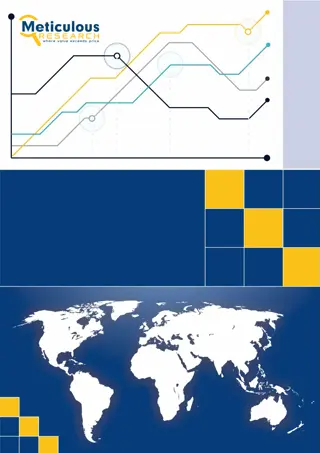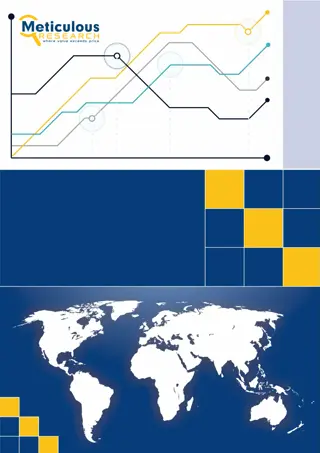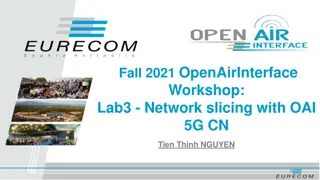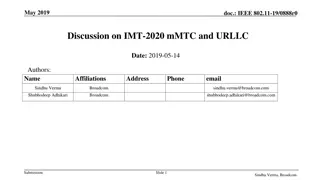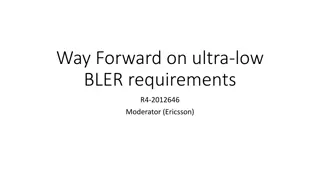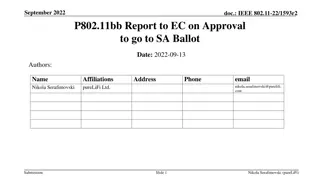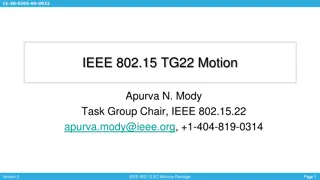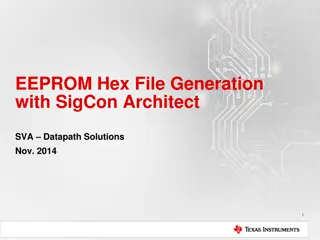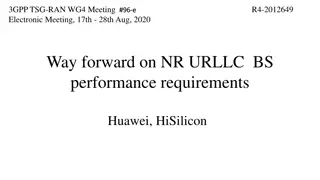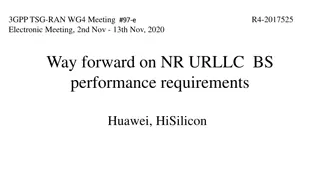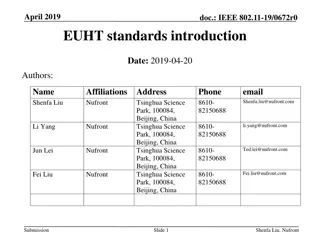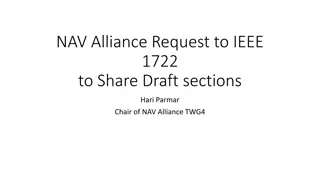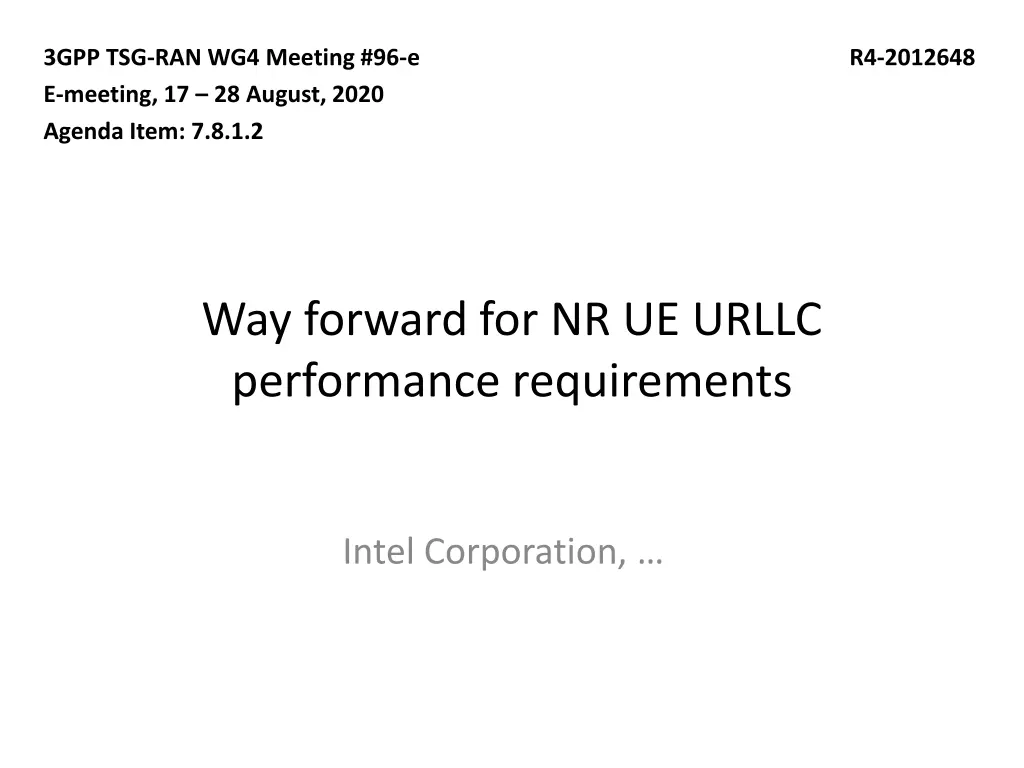
Defining Performance Requirements for 5G URLLC Services
Explore the detailed agenda and discussions from the 3GPP TSG-RAN-WG4 Meeting #96-e, focusing on defining performance requirements for URLLC in 5G networks. Delve into topics such as reliability, MCS selection, testing methodologies, and deployment scenarios for FR1 and FR2 bands. Companies like Intel, DoCoMo, and Ericsson advocate for defining high reliability requirements, while others like Apple and Huawei present contrasting views. Gain insights into PDSCH mapping, processing capabilities, and more crucial aspects shaping the future of 5G URLLC.
Uploaded on | 3 Views
Download Presentation

Please find below an Image/Link to download the presentation.
The content on the website is provided AS IS for your information and personal use only. It may not be sold, licensed, or shared on other websites without obtaining consent from the author. If you encounter any issues during the download, it is possible that the publisher has removed the file from their server.
You are allowed to download the files provided on this website for personal or commercial use, subject to the condition that they are used lawfully. All files are the property of their respective owners.
The content on the website is provided AS IS for your information and personal use only. It may not be sold, licensed, or shared on other websites without obtaining consent from the author.
E N D
Presentation Transcript
3GPP TSG-RAN WG4 Meeting #96-e E-meeting, 17 28 August, 2020 Agenda Item: 7.8.1.2 R4-2012648 Way forward for NR UE URLLC performance requirements Intel Corporation,
FR1 High reliability (1) Background (Agreed parameters from #94e, #94e-Bis and #95e) SCS/CBW: FDD: 15 kHz/10 MHz TDD: 30 kHz/40 MHz TDD pattern: 7D1S2U, S=6D: 4G: 4U for 30 kHz SCS. PDSCH configuration: Mapping type A, symbol length 12, starting symbol 2. Aggregation level: 2 for FDD and TDD Max number of HARQ transmissions: 4 FDD: No scheduling in slots 0 and 1 (or 19) within 20ms. TDD: No scheduling in D slots i, where mod(i, 10) = 0, and S slots Antenna configuration: 2x2 and 2x4, ULA low Propagation condition: TDLA30-10 Target BLER: 1% (BLER is calculated after all transmission ) Target Confidence level: 99% 2
FR1 High reliability (2) HARQ process number: 2 for FDD and 4 for TDD MCS: Option 1: MCS13 Option 2: MCS16 Option 3: MCS19 Methodology for MCS selection Higher or equal to -4 dB for final 4 Rx requirement definition (average ideal SNR alignment result + IM) BLER calculation method Method 1: BLER = NpacketFail/NpacketTx, where NpacketFailis the number of packets with CRC fail after all transmissions (initial and retransmissions), NpacketTxis the total number of packets transmitted during the test. Method 2: BLER = NtxFail/Ntx, where NtxFail is the number of transmissions (initial and retransmissions) with CRC fail, Ntx is the total number of transmissions during the test. Other methods are not precluded 3
FR2 High reliability Whether to define URLLC high reliability requirements for FR2 Option 1: Yes (Intel, DoCoMo, Ericsson) Option 2: No (Apple, Huawei, QC) Interested companies are encouraged to bring more information and analysis for the deployment/usage scenarios Test applicability rule for FR2 (only if FR2 is defined) Option 1: The performance requirements are only applicable for UE supporting FR2 operating bands Test applicability rule for FR1 and FR2 if UE support both (only if FR2 is defined) Option 1: UE should be tested only for FR1 if UE support both FR1 and FR2. Option 2: UE should be tested for both FR1 and FR2 if UE support FR1 and FR2 4
FR1 PDSCH mapping Type B and processing capability 2 (1) Background (Agreed parameters from #94e, 94e-bis and 95e) SCS/CBW: FDD: 15 KHz/10 MHz TDD: 30 KHz/ 40 MHz TDD pattern (30KHz SCS): DDDSU, S=10:2:2 Slots to be scheduled: FDD: All DL slots with K1=0 TDD: S slots with K1=0 PDSCH configuration: Starting symbol: 2 Symbol length for FDD and TDD: 2os only Slot aggregation level: 1 Max number of HARQ transmissions: 1 Number of HARQ process for FDD: 2 Channel model: TDLA30-10 Antenna configuration: 2x2 and 2x4, ULA Low. Test metrics: 70% throughput 5
FR1 PDSCH mapping Type B and processing capability 2 (2) Number of HARQ process for TDD: 2 MCS: Only MCS 4 6
FR2 PDSCH mapping Type B Test applicability rule for FR2: No need to define the applicability rule. Test applicability rule for FR1 and FR2: No test applicability rule is needed. SCS/CBW: 120 kHz/100 MHz TDD pattern: DDDSU with S = 10D:2G:2U PDSCH Configuration Scheduling: No PDSCH in slot 0 within 20 ms MCS: [MCS4] from table 1. Confirming the MCS depends on the simulation results to ensure a proper SNR value. Start symbol: 1 Symbol length: 2 Max number of HARQ transmissions: 4 Number of HARQ process: 8 Antenna configuration: 2x2, ULA low Channel model: Option 1: TDLC60-300 Option 2: TDLA30-300 Option 3: TDLA30-75 Test metrics: 70% throughput 7
Pre-emption indication (1) Background (Agreed parameters from #94e, 94e-bis and 95e) No URLLC PI performance requirements Time frequency set: 14x1 Number of symbols to be pre-empted: 2 Starting symbol to be pre-empted: 3 Pre-emption scheduling: Fixed scheduling Test applicability for eMBB UE PI requirements: optional with UE capability signalling Antenna Configuration: 2x2 and 2x4, ULA low 8
Pre-emption indication (2) Background (Agreed parameters from #94e, 94e-bis and 95e) Use the following parameters for eMBB PDSCH configuration Parameter Duplex mode Active DL BWP index Mapping type k0 Starting symbol (S) Length (L) PDSCH aggregation factor PRB bundling type PRB bundling size Resource allocation type RBG size VRB-to-PRB mapping type Value FDD, TDD 1 Type A 0 2 12 1 Static 2 Type 0 Config2 Non-interleaved PDSCH configuration VRB-to-PRB mapping interl bundle size N/A DMRS Type Number of additional DMRS Maximum number of OFDM symbols for DL front loaded DMRS Type 1 1 PDSCH DMRS configuration 1 FDD: 4, TDD: 8 Number of HARQ Processes Maximum HARQ transmission 4 The number of slots between PDSCH and corresponding HARQ-ACK information and TDD pattern FDD: 2 TDD: FR1.30-1 FDD: 10/15, TDD: 40/30 Full bandwidth Rank 1 TDLA30-10 CBW/SCS RB allocation MIMO layer Propagation condition 9
Pre-emption indication (3) The assumption of UE behaviours for buffer flushing and decoding If UE cannot decode the PDCSH correctly, UE feeds back NACK to gNB. Then UE flushes the buffer and waits for the next re-transmission for LLR combing to decode the PDSCH. URLLC interference modelling SNR: Same as for eMBB transmission Structure: Some random data Pre-emption probability Option 1: 10% within 1 radio frame Option 2: 20% within 1 radio frame eMBB MCS Option 1: MCS13 in Table 1 Option 2: MCS4 in Table 1 Test metric Option 1: 70% of max T-put Other options are not precluded Companies are encouraged to prepare comparison analysis of UE with and without HARQ buffer flushing of pre-empted bits to decide on options above 10
Test applicability Background (Agreement from 95e meeting) Test applicability for Rel-15 URLLC UE feature: The corresponding test applicability rules for the following features needs to be specified: PDSCH repetition (pdsch-RepetitionMultiSlots) PDSCH mapping type B (pdsch-MappingTypeB) PDSCH processing capability 2 (pdsch-ProcessingType2) new 64QAM MCS table for PDSCH (dl-64QAM-MCS-TableAlt) CQI table with target BLER of 10^-5 (cqi-TableAlt) Agreement for 96e meeting FFS whether UE URLLC requirements for Rel-15 features are release independent from Rel-15 No additional features and capability needed for URLLC Demod and CSI requirements introduced for Rel-15 feature under Rel-16 URLLC WI. 11
CR work split for UE Specification Requirements title Test applicability for all cases FRC for all cases Frequency range FR1 FR2 FR1 FR2 FR1 CR work CR Responsibility Huawei, HiSilicon Huawei, HiSilicon Intel Intel Ericsson Test applicability Test applicability FRC FRC Requirements Requirements for PDSCH with ultra-low BLER target (10-5) Requirements for PDSCH with aggregation factor configured Requirements for PDSCH for mapping Type B and processing capability 2 Requirements for PDSCH for mapping Type B Requirements for PDSCH for pre-emption indication CQI reporting test for table 3 FR2 FFS FFS FR1 Requirements Huawei, HiSilicon FR2 FFS FFS UE demodulation and CSI (38.101-4) FR1 Requirements Qualcomm FR2 Requirements Ericsson FR1 Requirements Ericsson FR1 FR2 Requirements FFS Apple FFS 12
Requirements for Rel-16 URLCC feature Requirements for Multi-TRP URLLC transmission schemes are covered by Rel-16 e-MIMO WI, no discussion in URLLC thread. Rel-16 features need to be discussed PDCCH enhancement Other features not precluded. 13

